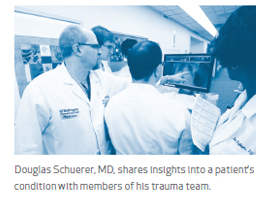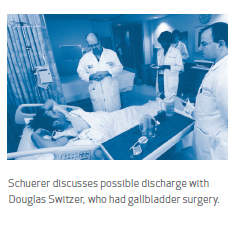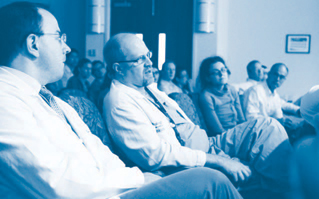A Day in the Life of a Trauma Surgeon: Douglas Schuerer, MD
Douglas Schuerer, MD, has been director of trauma at Barnes-Jewish Hospital for five years. His career began at the hospital nine years ago, following his residency at Henry Ford Hospital in Detroit and a fellowship in critical care at the University of Michigan. His plan to become a doctor was fixed in his mind when he was a teenager. “For as long as I can remember, I was always going to become a doctor. I think I was 16 when ‘Doogie Howser, M.D.’ first aired. My friends immediately nicknamed me Doogie Schuerer, MD,” says Schuerer.
Schuerer’s certainty about his career path is indicative of his demeanor as a trauma surgeon in one of the country’s top academic medical centers. His trauma team describes him as consistent, specific and efficient. Working in an urban emergency department and trauma center that treats more than 94,000 patients each year, Schuerer represents a constant in an ever-changing environment. His methodical, no-nonsense approach provides a level of comfort for staff. “Dr. Schuerer is technically gifted in the operating room. As a mentor, he is enthusiastic, a great teacher and an asset for the residents,” says Brian Bucher, MD, chief resident on the trauma service.
Schuerer and his seven physician partners who make up the Section of Acute and Critical Care Surgery in Washington University’s Department of Surgery rotate as on-call trauma surgeons in weeklong shifts.
They treat and care for a large number of patients with life-threatening injuries. In a recent weekend while serving as an on-call surgeon, Schuerer performed seven surgeries.
7:00 AM
EMERGENCY ROOM & TRAUMA DEPARTMENT
 Although there truly is no typical day in the life of a trauma surgeon, an on-call day shift starts at 7 a.m. Schuerer begins in the emergency and trauma department getting the most current information about patients from his partners who have worked the night shift. On this day, he and Bucher check on a woman who has been in a car collision and has a forearm fracture and other injuries. Schuerer talks to the patient about getting a chest CT scan, even though an X-ray has been done. Later, Bucher questions the necessity of additional radiation on the patient’s chest. Schuerer tells him that X-rays often miss injuries. “A patient with a high-risk mechanism of injury such as this car accident needs a CT scan. The benefits outweigh the disadvantages,” says Schuerer.
Although there truly is no typical day in the life of a trauma surgeon, an on-call day shift starts at 7 a.m. Schuerer begins in the emergency and trauma department getting the most current information about patients from his partners who have worked the night shift. On this day, he and Bucher check on a woman who has been in a car collision and has a forearm fracture and other injuries. Schuerer talks to the patient about getting a chest CT scan, even though an X-ray has been done. Later, Bucher questions the necessity of additional radiation on the patient’s chest. Schuerer tells him that X-rays often miss injuries. “A patient with a high-risk mechanism of injury such as this car accident needs a CT scan. The benefits outweigh the disadvantages,” says Schuerer.
This teaching moment is one of many throughout the day.
8:00 AM
TRAUMA UNIT ROUNDS
From the emergency department, Schuerer and Bucher move at breakneck speed upstairs to trauma units on the sixth floor, where they and a team of 10 to 12—including nurses, clinical nurse specialists and residents—perform rounds. They move through the halls as a unit, stopping at each room to share and discuss each patient’s treatment and progress, and then talk with and examine each patient.
Bucher has the primary responsibility of briefing Schuerer on each patient’s condition, which today includes those who have experienced small bowel obstructions, a gallbladder removal, ventral hernia repair and multiple gunshots. Every once in a while, a little humor surfaces in the conversation, creating a minor but necessary diversion in the hours of seriousness and concern that define the job.
10:00 AM
ICU ROUNDS
 This same day, Schuerer and another trauma team also perform rounds on ICU patients. The Saturday before, Schuerer provided 17 consults in 12 hours. The next day, he followed up with eight more.
Communication is a huge part of the trauma team’s routine. Not only does the team share patient progress during rounds, but they also meet weekly with a multidisciplinary group to discuss and document each patient’s treatment plan, special needs or circumstances and potential discharge date. “As an academic hospital, we incorporate learning and training into virtually everything we do. These informal meetings are one of the best ways to make that happen,” says Schuerer.
This same day, Schuerer and another trauma team also perform rounds on ICU patients. The Saturday before, Schuerer provided 17 consults in 12 hours. The next day, he followed up with eight more.
Communication is a huge part of the trauma team’s routine. Not only does the team share patient progress during rounds, but they also meet weekly with a multidisciplinary group to discuss and document each patient’s treatment plan, special needs or circumstances and potential discharge date. “As an academic hospital, we incorporate learning and training into virtually everything we do. These informal meetings are one of the best ways to make that happen,” says Schuerer.
11:00 AM
SURGERY
Though the need for surgery can arise at any time during a shift, on this day Schuerer performs two surgeries in the morning: the repair of a man’s leg that was run over by several motorcycles and a colostomy reversal. The first surgery takes less than an hour; the second well over two hours. Most people aren’t aware that trauma surgeons perform nontrauma-related surgeries, but this makes up a considerable amount of their surgical work.
RESEARCH & QUALITY IMPROVEMENT
In addition to responding to emergency trauma needs and teaching, the trauma surgeons conduct research and work on quality improvement for the trauma and surgical intensive care units. These functions are accomplished during the weeks in between on-call shifts. “Our first priority is to ensure that patients get safe and medically proven care. A big part of accomplishing this is through continuous improvements in patient safety and quality,” says Schuerer, who participated in the hospital’s Goldfarb Patient Safety and Quality Fellowship program from 2008 to 2009. “Recently we revamped the hospital’s massive-transfusion policy, which helps get the right blood products in large volumes for people who are bleeding to death. We were able to shorten the process, which is crucial to improving patient outcomes.” The policy impacts nontrauma patients, too.
 Schuerer also serves as director of the surgery critical care fellowship program at Washington University School of Medicine. Each year, the program recruits four general and specialty surgeons to train as leaders in surgical critical care. Fellows divide their clinical training among several intensive care units, including the 24-bed surgery/burn/trauma intensive care unit, cardiothoracic intensive care unit, neuro-intensive care unit, medical intensive care unit, coronary care unit and pediatric intensive care unit. “It’s an honor to have a hand in teaching the next generation of trauma surgeons,” says Schuerer.
Schuerer also serves as director of the surgery critical care fellowship program at Washington University School of Medicine. Each year, the program recruits four general and specialty surgeons to train as leaders in surgical critical care. Fellows divide their clinical training among several intensive care units, including the 24-bed surgery/burn/trauma intensive care unit, cardiothoracic intensive care unit, neuro-intensive care unit, medical intensive care unit, coronary care unit and pediatric intensive care unit. “It’s an honor to have a hand in teaching the next generation of trauma surgeons,” says Schuerer.
Schuerer’s impact on his patients, the trauma teams he works with and the hospital in general is apparent. Less apparent is the impact they have on him. Schuerer says the most difficult part of his job is “patients dying, especially young, innocent trauma victims.” The most rewarding part is “saving patients that others cannot, mostly due to the resources that Barnes-Jewish offers.”